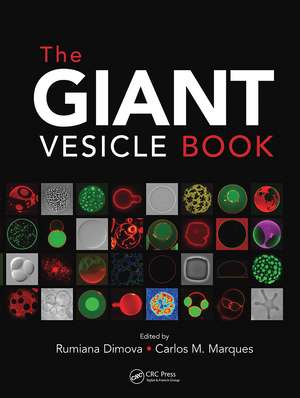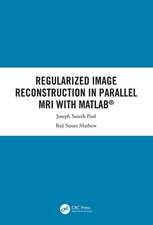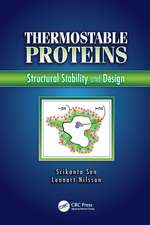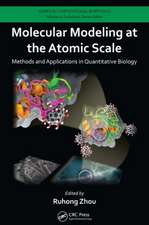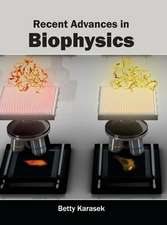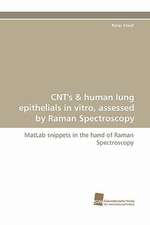The Giant Vesicle Book
Editat de Rumiana Dimova, Carlos Marquesen Limba Engleză Hardback – 7 oct 2019
Key Features
• A complete summary of the field, covering fundamental concepts, practical methods, core theory, and the most promising applications
• A start-up package of theoretical and experimental information for newcomers in the field
• Extensive protocols for establishing the required preparations and assays
• Tips and instructions for carefully performing and interpreting measurements with giant vesicles or for observing them, including pitfalls
• Approaches developed for investigating giant vesicles as well as brief overviews of previous studies implementing the described techniques
• Handy tables with data and structures for ready reference
Preț: 1238.13 lei
Preț vechi: 1647.09 lei
-25% Nou
Puncte Express: 1857
Preț estimativ în valută:
236.99€ • 257.51$ • 199.20£
236.99€ • 257.51$ • 199.20£
Carte tipărită la comandă
Livrare economică 21 aprilie-05 mai
Preluare comenzi: 021 569.72.76
Specificații
ISBN-13: 9781498752176
ISBN-10: 1498752179
Pagini: 676
Ilustrații: Essential colour figures; 25 Line drawings, color; 144 Line drawings, black and white; 25 Tables, black and white; 67 Illustrations, color; 172 Illustrations, black and white
Dimensiuni: 216 x 280 x 43 mm
Greutate: 2.04 kg
Ediția:1
Editura: CRC Press
Colecția CRC Press
ISBN-10: 1498752179
Pagini: 676
Ilustrații: Essential colour figures; 25 Line drawings, color; 144 Line drawings, black and white; 25 Tables, black and white; 67 Illustrations, color; 172 Illustrations, black and white
Dimensiuni: 216 x 280 x 43 mm
Greutate: 2.04 kg
Ediția:1
Editura: CRC Press
Colecția CRC Press
Cuprins
Preparation methods for giant unilamellar vesicles. Preparation and properties of giant plasma membrane vesicles and giant unilamellar vesicles from natural membranes. Protein reconstitution in giant vesicles. GUVs with cytoskeleton. Understanding giant vesicles – a theoretical perspective. Simulating membranes, vesicles, and cells. Theory of vesicle dynamics in flow and electric fields. Particle-membrane interactions. Theory of polymer-membrane interactions. Application of optical microscopy techniques on giant unilamellar vesicles. Mechanics assays of synthetic lipid membranes based on micropipette aspiration. Atomic force microscopy of giant unilamellar vesicles. Manipulation and biophysical characterization of GUVs with an optical stretcher. Vesicle fluctuation analysis. Using electric fields to assess membrane material properties in GUVs. Creating membrane nanotubes from GUVs. Measuring GUV adhesion. Phase diagrams and tie lines in GUVs. Vesicle dynamics in flow: an experimental approach. Membrane permeability measurements. Lipid and protein mobility in GUVs. Shining light on membranes. Protein-membrane interactions. Effects of antimicrobial peptides and detergents on guvs. Lipid-polymer interactions: effect on GUVs shapes and behavior. Polymersomes. Giant hybrid polymer/lipid vesicles. Giant unilamellar vesicles: from protocell models to the construction of minimal cells. Encapsulation of aqueous two-phase systems and gels within giant lipid vesicles. Droplet-supported giant lipid vesicles as compartments for synthetic biology. List of lipids and physical constants of lipid bilayers. List of membrane dyes and fluorescent groups conjugated to lipids. List of detergents. List of water-soluble dyes or their fluorescent groups and their structures
Notă biografică
Rumiana Dimova leads an experimental lab in biophysics at the Max Planck Institute of Colloids and Interfaces in Potsdam, Germany. She has been working with giant vesicles already from the beginning of her scientific career. After being introduced into the magic of their preparation during her studies as a student in Bulgaria, she remained fascinated by their application and over the years pursued a variety of projects employing giant vesicles as a platform to develop new methods for the biophysical characterization of membranes and processes involving them. Until now, these studies have resulted in more than hundred peer-reviewed publications. Recently, she was also awarded the Emmy Noether distinction for women in physics of the European Physical Society.
Carlos Marques, a CNRS senior scientist, founded the MCube group at the Charles Sadron Institute in Strasbourg, France, where he gears experimental and theoretical research towards the understanding of the physical properties of self-assembled lipid bilayers. Trained as a polymer theoretician, Carlos first got interested in membranes because they interact with polymers and published the first prediction for the membrane changes expected when polymers adsorb on lipid bilayers. He then expanded the scope of his group to include experiments and numerical simulations, and has now published many papers based on research with giant unilamellar vesicles, including the first study of lipid oxidation in GUVs and the discovery of the so-called PVA method for vesicle growth.
Carlos Marques, a CNRS senior scientist, founded the MCube group at the Charles Sadron Institute in Strasbourg, France, where he gears experimental and theoretical research towards the understanding of the physical properties of self-assembled lipid bilayers. Trained as a polymer theoretician, Carlos first got interested in membranes because they interact with polymers and published the first prediction for the membrane changes expected when polymers adsorb on lipid bilayers. He then expanded the scope of his group to include experiments and numerical simulations, and has now published many papers based on research with giant unilamellar vesicles, including the first study of lipid oxidation in GUVs and the discovery of the so-called PVA method for vesicle growth.
Recenzii
"Giant vesicles are artificial membrane systems used in basic biological research, applied research on smart materials, and medical and pharmaceutical applications. This massive volume provides a collection of 30 review articles, each an independent chapter, on this important topic. Editors Dimova (Max Planck Institute) and Marques (French National Centre for Scientific Research) are experts in the field, and the contributors represent an international group, with the majority of authors hailing from European countries. The chapters cover a diverse array of topics, including biophysics, cell and molecular biology, and physical chemistry. Because biophysics is a consideration, many chapters feature detailed mathematical treatments. The early part of the book provides a good summary of the field and its fundamental concepts. The articles are well referenced, drawing from the primary literature, and most include citations up to 2018. The book is beautifully illustrated with nice figures and callout boxes that highlight important protocols—some parts of the book resemble an advanced textbook. Chapter 4 (on the cytoskeleton) and chapter 10 (on light microscopy) were particularly informative to this reviewer. Chapters 15 and 19 provide web links to videos illustrating important concepts in vesicle dynamics. Several appendixes on topics such as membrane dyes and detergents are included."
-J. Z. Kiss, UNC-Greensboro, in CHOICE November 2020
-J. Z. Kiss, UNC-Greensboro, in CHOICE November 2020
Descriere
This practical manual gives the reader a toolbox for working with giant vesicles, including expert tips on preparation, measurement, and characterization methods. The contents build from a simple model to advanced membrane and cell system models. It also includes fundamentals for understanding vesicle structure, properties and behavior.
